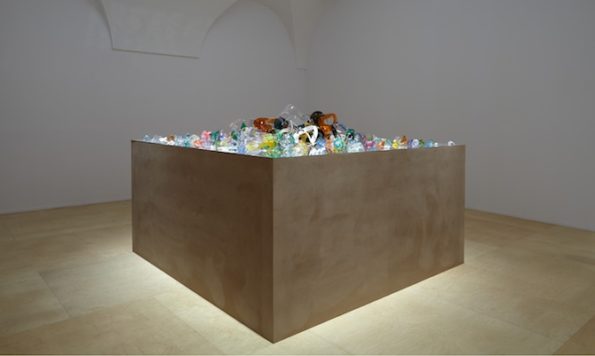Search
To search for an exact match, type the word or phrase you want in quotation marks.
A*DESK has been offering since 2002 contents about criticism and contemporary art. A*DESK has become consolidated thanks to all those who have believed in the project, all those who have followed us, debating, participating and collaborating. Many people have collaborated with A*DESK, and continue to do so. Their efforts, knowledge and belief in the project are what make it grow internationally. At A*DESK we have also generated work for over one hundred professionals in culture, from small collaborations with reviews and classes, to more prolonged and intense collaborations.
At A*DESK we believe in the need for free and universal access to culture and knowledge. We want to carry on being independent, remaining open to more ideas and opinions. If you believe in A*DESK, we need your backing to be able to continue. You can now participate in the project by supporting it. You can choose how much you want to contribute to the project.
You can decide how much you want to bring to the project.

Flags and wind. The complex relations between art, artist, museum and public tend to switch from «because» to «how» without anyone really taking any notice, as it is totally accepted that they can be complementary. However, as is well known, the words include nuances that are too often overlooked. «Because» always leads down a path with no exit; we’ve reached the answer, that’s it, it’s over. « How» talks to us about processes, about links, that as links can be broken and regenerated: a confusion of an unfathomable nature, a theory that generates more theory. By which a convulsive space is created that bewilders and challenges; or what comes to the same thing, aMuseo, in the words of Juan Luis Moraza (Tesoro público, Artium, 2014, pp. 64-67).
This «how», which always forms the epicentre around which Moraza’s work pivots, is in synthesis the reason for the show that the Museo Reina Sofia dedicates to the work of the artist. His structures – a selection of his works from 1974 to 2014, all with a strong poetic charge – constantly call into question whether we identify them as works of art. For when all is said and done: «[…] If you take the wind from a flag, is it not just an abstract painting», argues Juan Luis Moraza. If what is artistic is not necessarily important, then: What is art for? Why do we make our way to a museum or gallery? Is a project that fuses art and life possible?
According to what Moraza himself expounds, we can only aspire to something partially distanced from the dichotomy of the rational/irrational, «a bonus of shared pleasure » through complicities (Ornamento y Ley, 2007, p. 34-35). This de-dramatization of the artistic experience, by the artist as much as by the spectator, only seems to fit —Moraza seems to suggest— at the moment we reconsider the concept of the Museo as a space that is not alien. As a space in which to channel our life experiences, with the aim of achieving a transformation that doesn’t just encompass our personal ambit, so much as, even more importantly, encompasses the social. The roles of artist/spectator don’t disappear nor mutate, instead, they expand by Moraza’s inclusion of the anthropological dimension with the political, which is what differentiates the whole ensemble that is presented in the show with regards to the rest of the artistic proposals that can be seen today.
The wager of style. On the basis that democracy offers two aspects to the citizen (the dilemma that confronts passivity with participation), Moraza proposes the museum as a space of convergence between the citizen-artist and citizen-spectator. For the artist, the public question is not just a political issue it is also anthropological, intimately tied to the human condition, where we construct our identity. This anthropological question conceives the works of Moraza as a total wager on style, as a salutatory lesson against all forms of reduction—«Each wager on style is always a shot against simplification », he says— the banalities of which generate a superficiality that ends up driving the spectator to a plane of total indifference. With this wager, Moraza does nothing more than follow the route of the «how» that we mentioned earlier and which he takes steps to define clearly as: «[…] the style is the way: the way in which what one does constitutes oneself as a subject » (Tesoro público, Artium, 2014, p. 51).
Once again we find ourselves confronted with a process of construction of identity that seeks to distance itself from a world of fiction, repositioning the four implicated subjects (art, artist, spectator and museum) in reality – a space far removed from mysticisms and vacuous rhetoric— through the participation of the spectator within a Museo capable of creating links that promote tangible and positive changes.
Yet, this Museo, by its very procedural nature, can’t be a unique space, so much as it sets out to promote different models of participation which a establish a route that runs from representiality (intimacy) to representativity (extimacy). Moraza creates in this way a complex system of concepts in which to encompass the equally complex interlinking spaces of participation, which are presented as Participation Museum and Symbolic Museum (Emblems); as Demographic Museum and Morphological Museum (Devices); and as Anthropic Museum (Dividuals). In this latter space the individual is exposed as a being with internal and external fractures, configured by the artist into a complex entity, reformulated as a dividual.
The implexities and ineffable genius of romanticism. This new, complex Museo space of social implication that Morza proposes can’t arise, as we have seen, without the complicity of the spectator. This has to be an active, intentional complicity and has to take place within the space of convergence between complexity and implication presupposed by the Museo that Moraza has invented, a space that he defines with the term of implexity: a place that shelters in equal measure the rights and responsibilities of the artist and the spectator as part of society. A concept notably distant from the genius of romanticism—in clear allusion to the artistic subject —, and equally distant from the liberal entrepreneur—in relation to the spectator subject—: «[…] The ineffable genius of romanticism—a demiurge by which any system is an obstacle for truth— coincides with the liberal entrepreneur —for whom any legal limit is an obstacle to the creation of wealth— […] What they share is precisely this degree of irresponsibility towards society […]», explains the artist. One can say therefore that it is not about wagering against ourselves until we are satisfied with result, as occurred with the Ruletista by Mircea Cărtărescu, so much as quite the opposite, making our desires work in our favour. Hence cooperation and cordiality, as opposed to mistrust and disaffection, are the premises upon which the republic, that Juan Luis Moraza has managed to create, is founded.

"A desk is a dangerous place from which to watch the world" (John Le Carré)